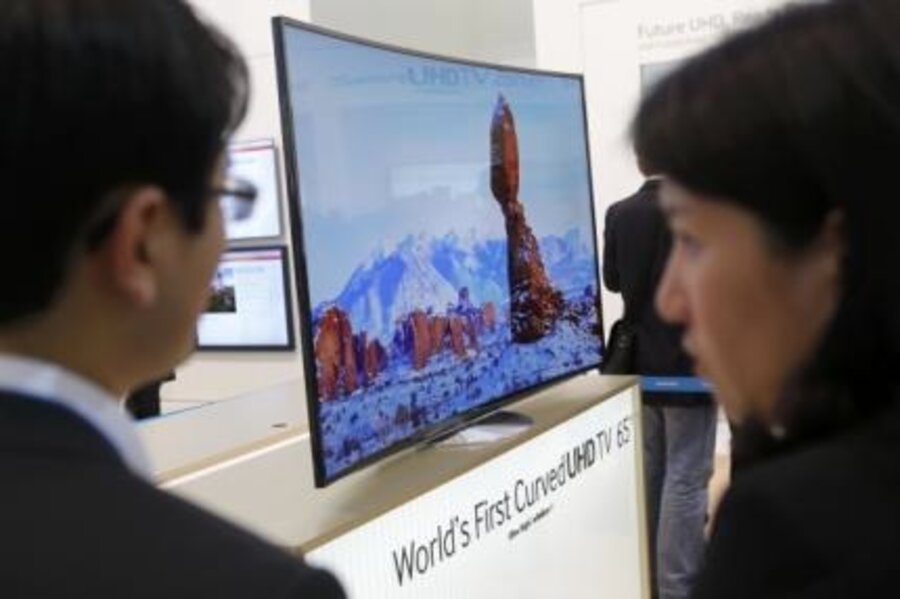Ultra HD and OLED TVs bring the big screen home
Loading...
Television is about to get Ultra detailed.
Following its highly anticipated Galaxy Gear and Note announcements Wednesday at the IFA tech conference in Berlin, on Thursday Samsung revealed its new 98-inch Ultra HD TV as well as a 55-inch Ultra HD OLED television. It also hinted at a 110-inch Ultra HD TV and other OLED sets to come.
Though the announcement left the tech world buzzing about the advancements in Ultra HD and OLED technology, those not familiar with these terms may be a bit confused as to what these tech acronyms and monstrously large televisions have to do with flipping through TV channels each night.
Ultra HD stands for Ultra High Definition. It’s also called 4K, which stands for the 4,000-or-so pixel resolution it offers, which is four times the number of pixels currently offered on high definition TVs. This high pixel count offers the clearest picture ever offered on consumer televisions – think 35mm film quality. This isn’t the first time Ultra HD TVs have come around: several major television manufactures (Sony, LG, Samsung, etc.) have toyed with the idea for years. But Samsung's new TV is the largest screen ever debuted with the technology. Why does this matter?
With HD TVs, screen size continues to expand but the number of pixels on screen (either 720x1280 or 1080x1920) stays the same. This means that, with jumbo-sized TV sets, viewers have to sit further away from their television in order to get the same crisp picture and HD experience. If you get too close, the pixelation become obvious. Ultra HD TVs have four times the amount of pixels as HD TVs, which means viewers can sit closer to the television without sacrificing clarity. Plus, with that many pixels, details really pop as the screen size expands. With smaller televisions, it gets harder to appreciate the quality difference between HD and Ultra HD.
The other big technology here, OLED, or organic light emitting diodes, affects the color contrast of the screen image. Currently, most TVs have LCD and LED screens. LED, or light emitting diodes, are essentially little light bulbs used to light up LCD, or liquid crystal display, screens. Since the LCD layer sits on top of the LED lights, some of the color contrast is lost. On the other hand, OLED screens are made up of organic compounds that light up when electricity runs through them. They shine all on their own, no need for multiple layers. This means that OLEDs can produce darker blacks, more refined colors, and more precise image movement.
So Ultra HD has clearer images and OLED has richer images. Put them together and that makes for one incredibly vibrant picture (and one extra-visually compelling episode of "Game of Thrones").
Will this be enough to send consumers scrambling to buy an Ultra HD or Ultra HD OLED TV? Price-wise, not likely. Samsung’s 85-inch Ultra HD model (formerly their largest) goes for $40,000, and the smaller, 55-inch model is priced at $5,270. Doubts have also been cast on manufacturers’ ability to mass-produce these screens, as the current demand for Ultra HD televisions is small and only prototype models of Ultra HD OLED have been created thus far.
In addition, few movies and TV shows are available in Ultra HD as of yet. Hollywood has slowly begun to shoot in 4K. “Skyfall” and “The Dark Knight Rises" were shot in Ultra HD, but there's currently no way to bring that super high-definition version home. You'll need to settle for normal HD, at least for now. Plus, those are both dark action films that benefit from the rich range of colors and more precise motion capture. Romantic comedies may not yet see the incentive to switch.
But since 3-D and Internet-capable televisions have failed to spark television sales the way HD televisions did in recent years, manufacturers are hoping Ultra HD OLED will be the next innovation that gets consumers off the couch and into stores.






